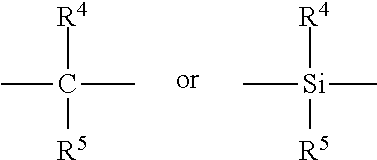Processes for Controlling the Viscosity of Polyalphaolefins
a technology of polyalphaolefin and viscosity, which is applied in the field of preparation of polyalphaolefin, to achieve the effects of reducing the molar ratio of aluminoxane cocatalyst, good viscometric properties, and careful control of the viscosity of pao polymers
- Summary
- Abstract
- Description
- Claims
- Application Information
AI Technical Summary
Benefits of technology
Problems solved by technology
Method used
Image
Examples
examples 2-6
[0056]Examples 2-6 were performed in the same manner as Example 1 except that borate was added on an equal molar basis (0.0288 grams of dimethylaniliniumtetrakis (pentafluorophenyl)borate) to the Ph2C(Cp-9-Flu)ZrCl2, and the MAO (reduced as described in Table 1 with toluene being substituted for the balance).
TABLE 1RUN#123456DescriptionPAOPAOPAOPAOPAOPAOPolymerization Temperature: (° C.)909090909090Polymerization Time: (Minutes)303030303030Co-Catalyst TypeMAOMAOMAOMAOMAOMAOWeight %: 10% (1.5M) mL12 [1.05 gr]6 [0.52 gr]3 [0.26 gr]2.4 [0.21 gr]1.2 [0.105 gr]0.6 [0.0525 gr][cocatalyst amount]H2 100% psig (kPag)50 (345)50 (345)50 (345)50 (345)50 (345)50 (345)Catalyst Activator Type:noneBorateBorateBorateBorateBorateActivator: (grams)00.02880.02880.02880.02880.0288Agitator Speed, rpm550550550550550550Decene, grams670670670670670670Co-Catalyst:Catalyst Ratio, MAO:Zr500:1250:1125:1100:150:125:1Activator:Catalyst Ratio, Borate:Zr 0:1 1:1 1:1 1:1 1:1 1:1Catalyst Concentration (M)0.00300.0030...
examples a-c (comparative)
[0059]A dried 3 liter Buchi reactor was filled under argon with 750 ml of dry 1-decene monomer. To this, 1.15 ml of a 25% by wt. solution of triisobutylaluminum in hexane was added to scavenge moisture and impurities, and the reactor temperature was brought up to 70° C. Once the temperature reached 70° C., 1 mole of hydrogen gas was added to the reactor via pressure drop from a vessel of known volume. Then, a solution of 0.007 g of Ph2C(Cp-9-Flu)ZrCl2 was dissolved in a 10 wt. % solution of MAO in toluene to obtain MAO to catalyst ratios of 250:1 to 1000:1 with 0.44 mmole of triisobutylaluminum. The catalyst solution was prepared 30 minutes prior to its use, and was injected into the stirring reactor under 200 psig (1379 kPag) argon pressure. The reactor was maintained at a temperature of 70° C. and 200 psig (1379 kPag) for a period of 30 minutes.
[0060]When complete, the reactor was depressurized and 400 ml hexane was added to the polymerized decene solution to aid in transfer. The ...
examples 7-9
[0064]A two liter stainless-steel oil-heated autoclave reactor was equipped with an agitator, 1-decene delivery system (pressurized flow and mass flow control), catalyst and hydrogen delivery system (pressurized flow and mass flow control with sub-surface hydrogen sparge) capable of achieving 300 prig (2068 kPa) pressure and 150° C. and overflowing at 1 liter liquid volume. The system was equipped with a closed loop temperature, pressure and flow control (on hydrogen, decene, and catalyst). Product was collected in a product tank for subsequent catalyst deactivation and analysis.
[0065]The catalyst solution was pre-made as follows. In a glove box free of oxygen, Ph2C(Cp-9-Flu)ZrCl2 catalyst, dimethylanilinium tetrakis(pentafluorophenyl)borate, dry toluene and 10% methylaluminoxane (MAO) in toluene was added to a clean 1 liter bottle equipped with dip-tube cap. The resulting mixture was mixed for 30 minutes. The bottle was sealed with the dip tube cap.
[0066]A reactor containing 1 lite...
PUM
| Property | Measurement | Unit |
|---|---|---|
| Volume | aaaaa | aaaaa |
| Mass | aaaaa | aaaaa |
| Mass | aaaaa | aaaaa |
Abstract
Description
Claims
Application Information
 Login to View More
Login to View More - R&D
- Intellectual Property
- Life Sciences
- Materials
- Tech Scout
- Unparalleled Data Quality
- Higher Quality Content
- 60% Fewer Hallucinations
Browse by: Latest US Patents, China's latest patents, Technical Efficacy Thesaurus, Application Domain, Technology Topic, Popular Technical Reports.
© 2025 PatSnap. All rights reserved.Legal|Privacy policy|Modern Slavery Act Transparency Statement|Sitemap|About US| Contact US: help@patsnap.com



